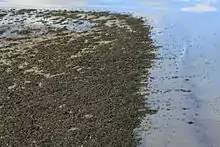Ephydra hians
Ephydra hians, common name the alkali fly, is a species of fly in the family Ephydridae, the brine flies.[2]
| Ephydra hians | |
|---|---|
 | |
| Ephydra hians at Mono Lake | |
| Scientific classification | |
| Kingdom: | |
| Phylum: | |
| Class: | |
| Order: | |
| Suborder: | |
| Section: | |
| Family: | |
| Subfamily: | |
| Tribe: | Ephydrini |
| Genus: | Ephydra |
| Species: | E. hians |
| Binomial name | |
| Ephydra hians | |
| Synonyms | |
| |
Description
The body of this species is dark brown. The thorax reflects a metallic greenish or bluish colour. It grows up to 4 to 7 millimeters in length. The wings are smokey brown.[3]
Larva
The larva contains a membranous cephalic area, the rest of the body is divided into 3 thoracic segments and 8 abdominal segments.[3]
Distribution
This species is found mostly in the northwestern United States, as well as in Canada and Mexico. The habitat with the greatest number is in the Mono Basin in California. Other concentrations of this species are found in Minnesota, North Dakota, and Washington.[3]
Habitat and behaviour

Ephydra hians live in the benthic-littoral zone in both soft and hard substrates.[3] Throughout the summertime, the flies, which live for 3 to 5 days, lay eggs on or under the water's surface. These hatch in a short time. The larvae roam the bottom, underwater, feeding on algae and bacteria. They can remain under the water until they develop into adults. They do not need to go to the surface to breathe. They acquire oxygen supplied by photosynthesis of the algae.
Once in the adult stage, the flies are able to walk upon and beneath the water, feeding on algae. They are able to submerge themselves to depths of up to 24 feet (7.3 m) thanks to short, waxy hairs on their body, which trap a bubble of air around their bodies. This bubble is not consumed by the fly as it clambers down submerged rocks, rather its surface area is used to transpire gasses with the lakewater. In this way, the diving flies can remain submerged for up to 15 minutes in their search for algae or secluded areas for egg-laying.[4] The saline lakes of their habitat is especially wet requiring the fly to have extra hair and special waxes to maintain the air bubble.[5] Writing in The Washington Post, Ben Guarino noted the flies "must exert forces 18 times their body weight to break through the surface tension of the water".[6]
Ephydra hians are susceptible to changes in temperature. When the temperature gets colder, their life span prolongs and the individual stages of development take longer. Adult flies do not lay eggs in the winter months due to the inability to have adequate developmental stages, thus creating a pause in reproduction. These flies also don't surpass roughly 15 meters deep due to the frigid temperatures and find that temperatures that are closely related to spring and autumn are the most suitable for growth. [7]
You can hold them under water as long as you please--they do not mind it--they are only proud of it. When you let them go, they pop up to the surface as dry as a patent office report, and walk off as unconcernedly as if they had been educated especially with a view to affording instructive entertainment to man in that particular way.
As food for humans
The Kucadikadi, a native American band, historically used the pupae of this fly as a source of protein and fat. The name "Kucadikadi" means "eaters of the brine fly pupae". Year round, but particularly in the summer, approximately 200 Kucadikadi harvested the pupae at Mono Lake. The pupae can be used to make stew after being dried. Considered a delicacy, the Kucadikadi also traded the pupae with others in the region.[2][9][10]
References
- Say, Thomas (1829). "Descriptions of North American dipterous insects". Journal of the Academy of Natural Sciences of Philadelphia. 6: 149–178. Retrieved 22 August 2015.
- "Mono's Alkali Fly: The First Fly You'll Ever Love". monolake.org.
- "The biogeography of the Mono Lake alkali fly". sfsu.edu.
- Life in the Great Salt Lake. Department of Botany, Weber State University.
- van Breugel, Floris; Dickinson, Michael H. (18 October 2017). "Superhydrophobic diving flies (Ephydra hians) and the hypersaline waters of Mono Lake". Proceedings of the National Academy of Sciences of the United States of America. 114 (51): 13483–13488. doi:10.1073/pnas.1714874114. PMC 5754803. PMID 29158381.
- Guarino, Ben (20 November 2017). "Watch these bizarre flies dive underwater using bubbles like scuba suits". The Washington Post. Washington, D.C. Retrieved 22 November 2017.
- Herbst, David B. (1 May 1990). "Distribution and abundance of the alkali fly (Ephydra hians) Say at Mono Lake, California (USA) in relation to physical habitat". Hydrobiologia. 197 (1): 193–204. doi:10.1007/BF00026950. ISSN 0018-8158 – via Sprinker Link.
- "Roughing It, Complete". gutenberg.org.
- "Alkali Flies - Nature Notes by Dr. Frank Lang". craterlakeinstitute.com.
- "Mono Lake". AMNH.
External links
| Wikimedia Commons has media related to Ephydra hians. |
- Map showing distribution in the United States (indicated by black squares)